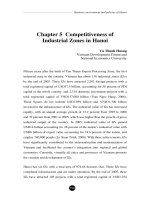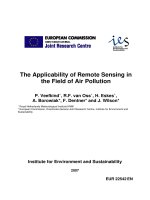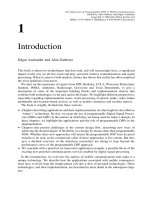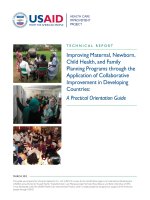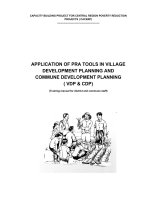Application of Industrial Engineering in Garment field
Bạn đang xem bản rút gọn của tài liệu. Xem và tải ngay bản đầy đủ của tài liệu tại đây (699.17 KB, 19 trang )
Industrial Engineering In Garment
Manufacturing
By,
Aravin Prince Periyasamy M.Tech (Textiles)
Industrial Engineering In Garment
Manufacturing
DEFINITION: Industrial Engineering is concerned with the design,
improvement and installation of integrate d systems of people, materials,
equipments and energy.
Mos t important aspect of I ndustrial Engineering is P RODUCTIVITY.
PRODUCTIVITY= INPUT
OUTPUT
Input refers to the resources like men, machinery, money and material
used to produce the output.
Output is the quantity of goods and services produced.
Industrial Engineering Techniques In
Apparel Industry
• One major technique of Industrial Engineering followed
in the Apparel Industry is the WORK STUDY.
• Work Study investigates the work done in the most
effective way of using the resources and with the
minimum time as possible.
• The phases of Work Study which are also the
techniques of Industrial Engineering used in the
Apparel Industry are-
1) METHOD STUDY
2) WORK MEASUREMENT
Method Study
• Method Study is the systematic recording and critical
examination of existing and proposed ways of doing work as a
means of developing and applying easi er and more effective
methods and reducing costs.
OBJECTIVES OF METHOD STUDY:
• To eliminate wastage of time and labour.
• To reduce fatigue and boredom of work by avoiding
unnecessary movements.
• To find the best way of doing a job.
• To have more effective utilisation of resources.
• To improve the design of work place layout.
• To train the worker in its practice as per the standard.
Procedure Of Method Study
• SELECT - Selection of the job or process to be studied.
• RECORD - Recording from direct observation everything that
happens using the most suitable methods like process charts,
diagrams, models, motion and film analysis, etc.
• EXAMINE - Examination of the recorded facts critically.
• DEVELOP - Development of the most economic method.
• MEASURE - Measurement of the quantity of work and
calculate the standard time.
• DEFINE - Definition of the new method and the related time.
• INSTALL - Installation of the new method as the new
standard practice.
• MAINTAIN - Maintenance of the new standard practice by
proper control procedures.
Method Study
• Method study is the first part of work study.
• It is the methodology of determining the best way to carry out any
job. It is not achieved by merely studying what has happened in the
past but also by examining how existing methods may be improved
and devise new methods.
• The investigation can be done through the following techniques of
method study.
• Flow charts – symbols
• Flow-process chart – comparison of the proposed method with the
present one with time and operation sequence using symbols
• Multiple Activity Chart – two or more activities
• String Diagram – Workplace represented with a pin, movement of
worker represented using a thread or string of cotton.
• Two handed process chart – Both the hand movements recorded
simultaneously with respect to time.
There are a few other techniques also like simo chart, micromotion
study, therbligs,etc
Purpose Of Method Study
• To determine the optimum working method.
• To standardize the work.
• To train the workers.
• To manage the work.
• LEVELS OF ANALYSIS OF METHOD STUDY
• WORK PROCESS LEVEL – Eg: Sew the front tuck.
• WORK COMPONENT LEVEL – Eg: Take the garment body,
fold the tuck,allign the needle entry point, reverse stitch.
• MOTION COMPONENT LEVEL – Eg: Extend the hand to
the garment, grasp the garment body, bring the garment
body to the table, place the garment body on the table.
Work Measurement
• Work Measurement is the application of
techniques designed to establish the time for
a qualified worker to carry out a specified job
at a defined level of performance.
• OBJECTIVES OF WORK MEASUREMENT:
1) Raise the production efficiency with little
additional cost.
2) Work improvement through work
simplification.
3) Setting up of standards of performance.
4) Indication if material control and
maintenance are not functioning properly.
Procedure Of Work Study
• SELECT - Selection of the work to be studied.
• RECORD - Recording the relevant data relating to the
circumstances in which the work is being done and also the
methods and elements of activity in them.
• EXAMINE - Examination of the recorded data and the detailed
breakdown critically to ensure that the most effective method and
motions are being used.
• MEASURE - Measurement of the quantity of the work involved
in each element in terms of time.
• COMPILE - Compilation of the standard time for operation.
• DEFINE - Definition of the series of activities and method of
operation for which the time has been compiled.
Time Study
• Time Study is the art of observing and
recording the time required to do each detailed
element of an industrial operation.
• A Time Study consists of the following:-
1) Dividing a certain item into minute work
components.
2) Recording the time required to finish the work
using the appropriate time measuring device.
3) Specifying the standard time and making work
improvements based on the results obtained.
Establishing Standard Time
Select,record,examine and measure quantity of work performed using the technique
WORK SAMPLING
STOP WATCH TIME STUDY
PREDETEMINED TIME STANDARS
Compile with allowance to get standard time of operations
Compile to get standard time of operations
Techniques Of Establishing Standard
Time
• WORK SAMPLING: It is the method of finding the
percentage occurrence of a certain activity by
statistical sampling and random observations.
• STOP WATCH TIME STUDY: It is the method of
recording the times and rates of working for the
elements of a specified job carried out under specific
conditions and for analysing the data.
• PREDETERMINED TIME STANDARDS: They are
the advanced techniques which aim at defined the
time needed for the performance of various
operations by derivation from pre-set time standards
for various motions.
Plant Layout
• Plant layout is defined as a technique of locating different machines and
plant services within the factory so that the greatest possible output of
high quality at lowest possible total cost can be available.
MAIN OBJECTIVES OF A PLANT LAYOUT:
1) Maximum utilisation of the floor space.
2) Lighting and ventilation of areas .
3) Fewer ac cidents
4) Minimizing production delays
5) Space for future expansion.
DIFFERENT TYPES OF LAYOUT
• Line or Product Layout – operational sequence.
• Functional or Process Layout – assembling of similar operations
• Fixed or Position Layout – product materials are too heavy to move
around;tools carried(eg.aircrafts)
• Combination Layout – products manufactured and assembled.
Production Systems
• A production system is defined as a framework of activities within
which the creation of value can occur.It can be of two types for a
product:-
Continuous System – item being processed is not stored
properly.(e.g lap transferred through the chute system)
Intermittent System – item being processed is stored temporarily in
storage areas.(e.g lap transferred through trolleys)
CLASSIFICATION OF PRODUCTION SYSTEMS
Whole Garment Production System
Complete Whole Garment Production System
Departmental Whole Garment Production System
Section Production System
Sub Assembly Line System
(i) Unit Flow System
(ii) Multiple Flow system
Progressive Bundle System
(i) Garment Bundle
(ii) Job Bundle
Types Of Production Systems
• Complete Whole Garment Production System – entire
garment from cutting to final completion;expensive;production is
low.
• Departmental Whole Garment Production System – work
done with respect to the various departments;all component parts
move together from department to department;production is high.
• Sub Assembly Line System – two or more operations made on
the same garment;two or more assembly lines merge.
• Unit Flow System – each garment part moves to the next
workstation after the work is completed.
• Multiple Flow System – two or more of the same parts being
processed move to the next workstation at the same time in a
group or bundle.
• Garment Bundle – bundle contains all parts of a garment carried
by conveyors between workstations.
• Job Bundle – bundle contains pieces on which two or more
operations may be performed.
Line Balancing
• Line balancing is defined as distributing tasks evenly over the
workstations so that the idle time of men and machine is
reduced.
• It aims at grouping the tasks and workers in an efficient pattern
I order to obtain the optimum or most promising balance and
also flow of production.
METHODS OF LINE BALANCING
Largest Candidate Rule Method – Work elements listed along with
the time taken in the order they are done;listed in descending
order of the time taken;workstations assigned by summing up
the time taken and keepin in mind not to exceed cycle time.
Kilbridge and Webster’s Method – Work elements listed and
divided into columns with the respective time taken;assign
workstations summing up the time taken and not exceed cycle
time.
Ranked Positional Weights – rank positional weight for each
element is calculated;elements listed with the largest RPW value
at the top;assign workstations not exceeding cycle time.
Ergonomics
• Ergonomics Is Defined As The Scientific Study Of The
Relationship Between Man And His Working Environment.It Is
The Combined Activity To Solve Problems At The Interface Of
People And Machine.Such A Combined Integration Goes A
Long Way To Evaluate The Effects Of Interactory Factors On
“Productivity”.
• Main Functions Analysed By Ergonomists Are- Body Motion,
Fatigue, Accommodation To Fit,stress,comfort And Force.
Objectives Of Ergonomics:
1) Optimise The Integration Of Men And Machine In Order To
Increase Work Rate And Accuracy.
2) To Provide The Worker With A Workplace Befitting The Needs
And Requirements.
3) Equipment,machinery And Controls Should Be Such That
Minimal Mental And Physical Strain Is Given To The Worker
Thereby Increasing Efficiency.
4) A Conductive Environment For Executing The Task Effectively.
Material Handling
• Material Handling is concerned with mov ing the right quantity of materials-raw
materials,machinery spares, work-in-progress and finished goods at the right time
in a given space.
• The movement of materials can be vertical;horizontal;in batches or in a single unit.
• Material handling increases only the cost of the product and not the value of the
item.
• Material Handling Equipments are of 2 types-Fixed Path equipments
(e.g Conveyors) and Variable Path Equipments(e.g Forklifts)
• PRINCIPLES OF MATERIAL HANDLING
1) Minimise the movements involved in production operation.
2) Moving optimum number of pieces in one unit.
3) Minimise the distances moved by adopting the shortest routes.
4) Employ mechanical aids in place of manual labour in order to speed up the
material movements.
5) Utilise gravity for assisting material movements.
6) Safe,standard and efficient material handling equipment must be chosen.
7) Material handling equipments must be resorted to periodic check ups,repairs and
maintenance.
Result Of Using The Industrial
Engineering Techniques
WORK STUDY
METHOD STUDY WORK MEASURMENT TIME STUDY
HIGHER PRODUCTIVITY
